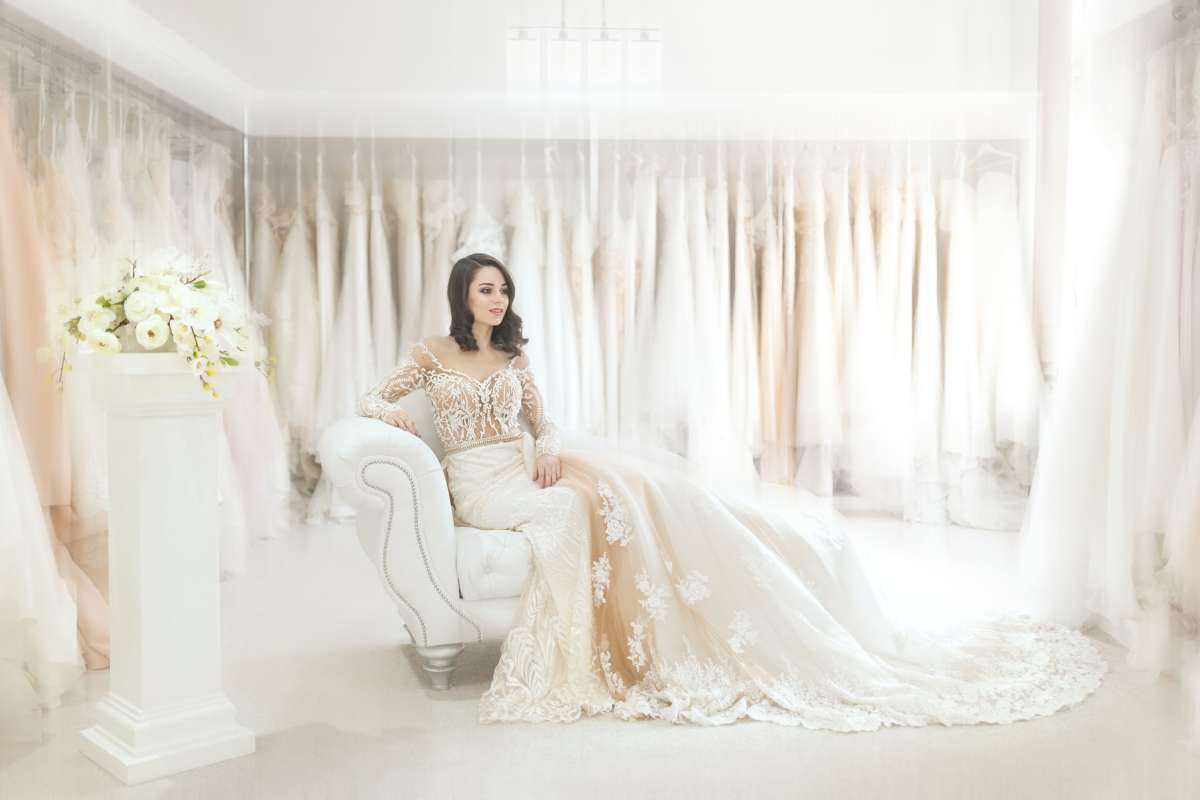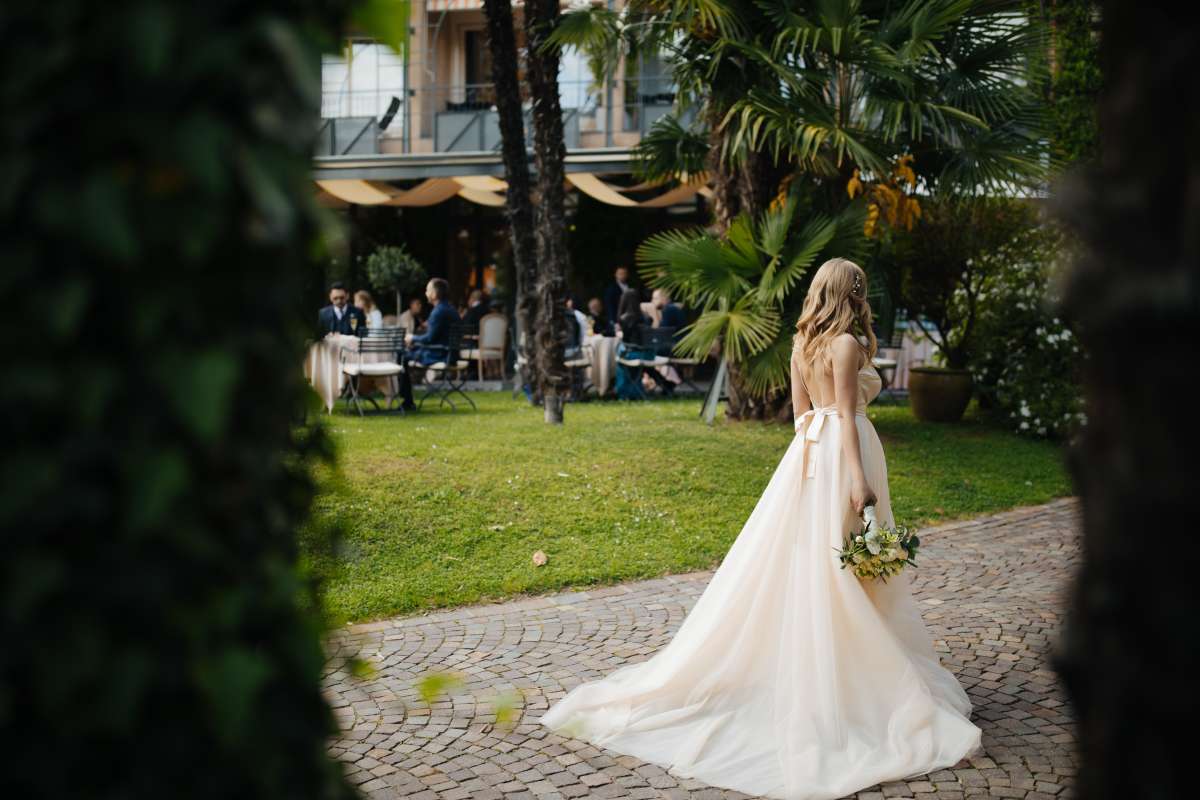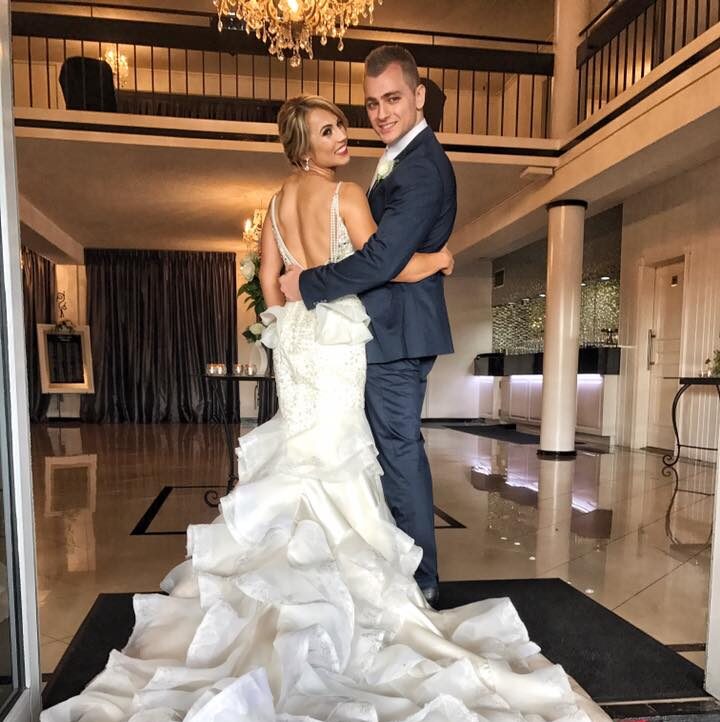Dyeing your wedding dress might sound like a bold choice, but more brides are choosing this route to make their gown truly their own. Whether it’s giving a vintage dress a second life or adding a personal pop of colour, dyeing offers a unique way to transform your wedding look. But before you dive in, there’s more to it than just choosing a colour. From fabric types to embellishments, the dyeing process comes with its challenges. In this guide, I’ll share what you need to consider before taking the plunge and how to achieve the best results.
Why Dyeing Your Wedding Dress Might Be the Perfect Option for You
The Growing Trend of Dyeing Wedding Gowns for a Unique Look
When I first started working in the wedding industry, dyeing a wedding dress was practically unheard of. Brides were so attached to the idea of their dress staying pristine, all white, ivory, or champagne. But today? It’s a whole new world. Brides are embracing the idea of dyeing their dresses to add personality, especially as trends shift toward unique and personalised weddings.
I’ve seen this trend grow firsthand, from simple ivory gowns being dyed in soft pastels to full-on dramatic transformations into jewel tones. Dyeing a wedding dress is an excellent way to stand out, and it’s more popular than ever. Brides love it because it’s also a cost-effective way to update an existing gown instead of splurging on a completely new one.
One couple I worked with had their heart set on a vintage, off-the-shoulder wedding gown. It had seen better days, but was still in great shape. After discussing it, they decided to dye it a soft lavender, breathing new life into the dress and making it completely unique. The final result? Stunning.
Can You Really Dye a Wedding Dress?
In short: yes, you can dye a wedding dress. But like anything worth doing, it comes with a set of challenges. The fabric, embellishments, and even the original colour of the dress all play a role in how well the dyeing process will go.
I always advise brides to start by checking their dress’s fabric type. For example, silk, cotton, and linen take dye very well, producing vibrant, rich colours. But polyester and other synthetics? Well, they’re a little more temperamental, requiring special dye and more care.
If you’re a bride who loves the idea of a personalised, adventurous wedding look, dyeing might be your perfect solution. But before you jump in, it’s important to do a little research to ensure you’re not risking a DIY disaster!
Key Factors to Consider Before Dyeing Your Wedding Dress
Fabric Matters: What You Need to Know About Wedding Dress Materials
When I first help a bride find her dress, fabric is always where we start – it’s one of the most important aspects of a gown. You can have a gorgeous design, but if the fabric isn’t right for you, it’s not going to work. The same applies when dyeing your dress.
Here’s what you need to know:
- Natural Fabrics: If your dress is made from natural fibres like silk, cotton, or wool, it’s more likely to absorb dye well. Silk wedding gowns, for example, take dye beautifully, resulting in deep, vibrant colours.
- Silk Organza and Silk Tulle: These fabrics are perfect for dyeing, producing beautiful, rich tones.
- Cotton Lace: If your dress has cotton lace, it will also dye easily.
- Synthetic Fabrics: These can be trickier, as they often require special dyes. For example, polyester or nylon requires disperse dyes. While they can still be dyed, results may not be as predictable, and you could face some challenges.
- Polyester Satin: While some synthetic fabrics like polyester satin will take dye, it can be difficult to get vibrant results. Many of these fabrics are treated to resist stains and water, making them more resistant to dye.
- Polyester Organza: This is a bit of a mixed bag. While some pastel shades can work, achieving a rich, dark colour is tough.
The Challenge of Dyeing Dresses with Embellishments
It’s one thing to dye a simple fabric, but what if your dress has embellishments like lace, sequins, or beads? These elements can complicate the process.
- Lace: Lace fabric can take dye well, especially if it’s cotton-based. However, you’ll need to consider how much of the lace is exposed to the dye.
- Sequins & Beads: Beads, especially if they are made of plastic, can absorb dye, leading to uneven colouring. Metal beads, rhinestones, and glass elements typically won’t take dye and may cause an uneven effect.
- Delicate Details: Embellishments like metallic threads or glued rhinestones can be easily damaged or may not absorb dye evenly. If you’ve got a heavily embellished gown, you might want to consider removing or protecting these details before dyeing.
How to Achieve the Perfect Wedding Dress Colour: DIY vs. Professional Dyeing
DIY Wedding Dress Dyeing: Is It Worth the Risk?
Dyeing your wedding dress yourself can be an exciting, hands-on way to personalise your gown. But let me tell you – it’s not for the faint of heart. It requires patience, the right equipment, and a careful eye to avoid common mistakes.
DIY Dyeing: Steps to Take
Here’s a step-by-step guide if you decide to go the DIY route (but always make sure you’re fully prepared):
- Choose the Right Dye: Depending on the fabric, you’ll need different types of dye. For natural fibres like cotton or silk, I recommend Rit Liquid Dye. For synthetics like polyester, you’ll need a dye made specifically for those materials (e.g., disperse dye).
- Prepare Your Dress: Wash your dress before dyeing it to remove any dirt or oils. I always recommend testing a small swatch of fabric first to check how the dye reacts.
- Set Up Your Dye Station: You’ll need a large enough container to fully immerse the dress in the dye. Protect your workspace with plastic covers and make sure you’re using rubber gloves and eyewear.
- Dyeing the Dress: Follow the dye manufacturer’s instructions carefully. Immerse your dress in the dye and stir gently for even coverage. It typically takes about 30 minutes to achieve the desired colour.
- Rinsing and Drying: Once you’ve achieved your desired shade, rinse the dress in cold water until the water runs clear. Lay it flat on a towel to air dry.
Risks of DIY Dyeing
- Uneven Colour: If the fabric isn’t fully submerged or agitated enough, you might end up with patchy or tie-dyed results.
- Fabric Damage: Some delicate fabrics, like silk or satin, may not hold up well to dyeing and could become damaged.
- Long-Term Wear: Dyeing with home kits may lead to fading or colour bleeding over time, especially if the dress is washed frequently.
Why You Should Consider Professional Dyeing Services
Now, here’s the thing. DIY dyeing might sound tempting, but if you’re looking for a flawless result or have a more delicate gown, professional services are the way to go. In fact, I’ve had many clients come to me after trying to dye their wedding gowns themselves, only to be disappointed with the results.
Why Go Professional?
- Expertise and Precision: Professionals have the knowledge and equipment to dye your dress perfectly, including handling delicate fabrics and intricate embellishments.
- Preservation of Details: They know how to protect delicate embellishments like lace, beads, or sequins while ensuring the rest of the dress gets a flawless dye.
- Custom Dye Formulation: Professional dyeing services can mix dyes to create the perfect shade, matching your exact vision.
- Guaranteed Results: No more worrying about uneven dye jobs or risking ruining your gown. Professionals give you the peace of mind that your dress will turn out exactly as you want.
For instance, one bride I worked with wanted her classic A-line wedding dress dyed a soft blush pink. The professional dyeing service did an excellent job – the dress came out beautifully without damaging the fabric or embellishments.
Alternatives to Dyeing Your Wedding Dress
If you’re not completely sold on the idea of dyeing your wedding dress – or if you’re just looking for a less permanent option – there are a number of fantastic alternatives that can still help you achieve the look you want without taking the dye plunge.
In my years of experience, I’ve worked with brides who wanted to add that extra personal touch but weren’t keen on dyeing. From accessories to overlays, here are some great options for transforming your dress:
Add Colour with Accessories: Simple, Effective, and Stylish
Sometimes, adding a pop of colour can be just as effective as dyeing the entire gown. Accessories like a colourful sash or bridal belt can make a huge impact without altering the fabric of the dress.
- Sashes & Belts: A satin, velvet, or even lace belt in a bold colour can instantly transform your look. I’ve seen brides opt for deep burgundy, blush pink, or even navy, depending on their wedding theme.
- Bridal Veils: Adding a coloured veil is another way to add some personality without changing the gown itself. Imagine a soft champagne veil against a white dress – it’s a subtle yet stunning touch.
- Shoes & Jewellery: Don’t overlook the power of shoes or jewellery. A pair of red heels or a statement necklace can be all you need to make a statement.
Using Overlays or Boleros to Add a Pop of Colour
For those who want a dramatic change, adding an overlay or bolero to the dress can create an entirely new look. Layering a coloured fabric over your dress allows you to customise the style without committing to a permanent dye job.
- Colour Coordination: It’s important to choose a colour that complements the base colour of your dress. For example, a champagne gown can look stunning with a soft ivory overlay, or a more dramatic contrast with a ruby red.
- Fabric Compatibility: Look for overlays or boleros in materials that match or complement your dress fabric – for example, lace or tulle for a soft, feminine touch. The idea is to make the overlay seem like a seamless part of the gown.
- Fit and Size: Make sure that the overlay or bolero fits correctly, so it enhances the shape and silhouette of your gown rather than overwhelming it. Consider a bolero with a delicate lace design or a satin overlay for an elegant finish.
Temporary Dyeing Techniques: Change the Look Without Commitment
If you’re really craving a change but aren’t ready to commit to a permanent dye, there are several temporary fabric dyeing techniques that can give your dress a new look for your wedding day.
Here are some popular methods to consider:
- Fabric Spray: This is a fast and simple option to add a splash of colour to your dress. You can spray specific areas of your dress, like the hem or the bodice, to create an ombre effect or a more subtle gradient. However, keep in mind that fabric spray isn’t as long-lasting as other methods and might fade over time.
- Dip Dyeing: If you’re after a trendy, gradient look, dip dyeing is a great option. You can dip only the bottom of your gown into the dye bath to create an ombre effect, or partially dip different sections for a softer, more customised look. This technique works best with lighter-coloured gowns.
- Fabric Markers or Paint: For a bit of artistic flair, some brides choose to use fabric markers or paint to add small touches of colour. Whether it’s a delicate design near the hemline or a personalised touch on the bodice, this method allows you to go as bold or subtle as you like. Just be sure to test the markers or paint on a scrap piece of fabric first.
I’ve worked with a bride who wanted her dress to have a subtle gradient effect in shades of blue. She decided to dip-dye the lower half of her dress, and the result was stunning – a soft, pastel blue that gradually deepened into a rich navy. The effect was beautiful, and the dress remained completely intact!
Other Customizations
If you’re hesitant to dye your dress but still want to make it truly yours, there are other creative customisation options worth considering:
- Shortening the Dress: If you have a traditional long wedding gown, consider having it shortened to knee or tea-length for a more casual look. This can give your dress a completely different vibe without altering the colour. The leftover fabric could even be repurposed for accessories like a matching clutch or flower girl dress.
- Adding a Denim Jacket: Want to make your dress more casual and fun? Try pairing it with a denim jacket. This can completely shift the tone of your wedding look and make for some great post-ceremony photos.
- Changing the Belt Trim: You can replace or add a new belt trim to your dress, or incorporate some beads, sequins, or ribbons to alter the look. Small touches like this can have a big impact and refresh the style without major changes to the dress itself.
Dyeing Your Wedding Dress: A Few Final Thoughts
The Pros and Cons of Dyeing Your Wedding Dress
Dyeing your wedding gown can be a fantastic way to make it truly your own, but there are several factors to consider before diving in:
Pros:
- Personalised Look: Dyeing gives you a chance to express your personal style and break from tradition.
- Cost-Effective: It can be cheaper than buying a brand-new dress if you already have a gown you love.
- Eco-Friendly: If you already own a dress that you’re emotionally attached to, dyeing it is an environmentally friendly alternative to buying a new one.
Cons:
- Risk of Damage: Dyeing delicate fabrics can cause irreversible damage, especially with synthetic fibres.
- Uneven Results: The colour might not be as even as you’d like, particularly if your dress has multiple types of fabric or embellishments.
- Colour Fading: Depending on the dye, the colour may fade over time, especially after multiple washes.
I once worked with a bride who had a simple yet elegant A-line wedding dress. She loved it but wanted something more modern and unexpected. After some discussions, she decided to dye the gown a soft lavender. The results were stunning – the fabric absorbed the colour beautifully, and the bride looked radiant in her one-of-a-kind gown. The best part? She saved money by reusing the dress, and it still looked brand new!
Should You Dye Your Wedding Gown?
So, is dyeing your wedding gown right for you? The answer depends on a few key factors – fabric, colour, embellishments, and the level of risk you’re comfortable with. But with the right preparation and careful consideration, dyeing your dress can be an incredibly rewarding experience.
If you want to take the risk and make your dress unique, go for it. But if you’re looking for something with guaranteed results, a professional service might be the best route. Either way, make sure to plan carefully, and most importantly, enjoy the process of making your wedding gown truly yours!
Let’s Get Straight to the Point
Dyeing your wedding dress can be a great way to personalise your gown, but it requires careful consideration. Factors like fabric type, embellishments, and original colour can affect the final outcome. Natural fabrics like silk and cotton tend to take dye well, while synthetics like polyester may require special dyes and techniques. Whether you go DIY or professional, dyeing can be rewarding but comes with risks, such as uneven results or fabric damage. Alternatives like accessories or overlays can also add colour without the commitment. Always test first, and consider professional help for a flawless finish.




